Since taking over this column from Mike Rosenberg last year, I’ve tried to avoid featuring cards that we already discussed in our preview weeks. The writers here at Metagame.com always do a thorough job explaining all the potential uses for a new card, and I figure it would be old hat to talk about something that we’ve already run.
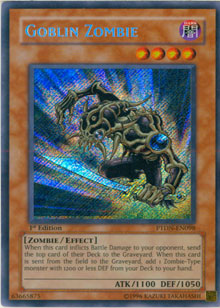 That theory rings doubly true in the case of my article today—after all, when you’ve got Matt Peddle telling you how good Goblin Zombie is, what’s really left to say? Superfriends built the Zombie strategy as we know it, and Peddle’s contributions to the team make him a definite expert. That’s why Matt got that assignment in the first place. Can I really add anything to that?
That theory rings doubly true in the case of my article today—after all, when you’ve got Matt Peddle telling you how good Goblin Zombie is, what’s really left to say? Superfriends built the Zombie strategy as we know it, and Peddle’s contributions to the team make him a definite expert. That’s why Matt got that assignment in the first place. Can I really add anything to that?
I’ve asked myself that question several times since the Phantom Darkness Sneak Previews, and up until recently the answer was a resounding "no." Matt had said everything there was to say about the card, so no matter how much I marked out for the little Zombie that could, there wasn’t much reason for me to analyze it again. I might as well have just linked to Matt’s article. So I stopped asking myself that question and wrote on stuff we hadn’t previewed.
Until today. Looking at Goblin Zombie, playing it myself, and having seen it played on the sidelines at Shonen Jump Championship Houston, I think there’s now more to this card than anyone first suspected. Weeks ago, Matt wrote that Goblin Zombie was just what Zombies needed in order to compete in a combo-heavy metagame. Weeks later, the prediction of a combo-driven game has definitely come true, and the time is right for a super-fast swarm deck to hit the scene. But some of the recent trends at big competitions have made Goblin Zombie even better, and that’s why I want to give it a second look today.
The Wonders Of Zombie Master
You can actually search for a surprising number of Zombies with Goblin Zombie’s effect, but just as Matt said in his preview article, the most important one is Zombie Master. Zombie decks frequently win or lose depending on whether or not they got to see two copies of Zombie Master over the course of the duel, and doing so makes victory far easier to achieve. Once that drawing loop gets started with Card of Safe Return, a Zombie deck becomes incredibly difficult to stop. Every copy of Goblin Zombie that you add to your deck basically adds another Zombie Master to the mix, making it far easier to get to.
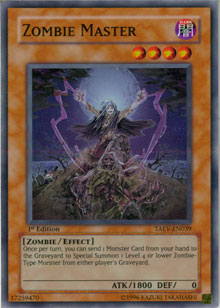 This has three effects, all of which are pretty predictable. For one, Zombie decks become more reliable. It’s a lot easier to get to your central combo and that means a far more consistent performance. Two, the deck gets faster: you don’t have to wait so long in order to put together a draw combo good enough to justify dropping Card of Safe Return to the field. Three, you can use Pyramid Turtle to search out Ryu Kokki and Il Blud more often, eliminating most of those instances where using it to search for Zombie Master was the correct play. That improves the quality of your draws by reducing the chances of drawing tribute monsters.
This has three effects, all of which are pretty predictable. For one, Zombie decks become more reliable. It’s a lot easier to get to your central combo and that means a far more consistent performance. Two, the deck gets faster: you don’t have to wait so long in order to put together a draw combo good enough to justify dropping Card of Safe Return to the field. Three, you can use Pyramid Turtle to search out Ryu Kokki and Il Blud more often, eliminating most of those instances where using it to search for Zombie Master was the correct play. That improves the quality of your draws by reducing the chances of drawing tribute monsters.
Truth be told, this was Matt’s central point and it’s still the most important. Goblin Zombie makes Zombie decks more consistent and faster, as well as freeing up their options. But from there, it also does more cool, beneficial things that make the deck a born-again tourney-winner.
Enabling Over-Extension
Zombies love to over-extend. It’s what swarm decks do: slap a bunch of monsters onto the field, commit cards, and then wreck your opponent’s field while you bash your way towards his or her life points. And, to their credit, Zombies are pretty good at over-extending: once Card of Safe Return is active, any monster special summoned by Zombie Master is going to replace the card you discarded with a free draw. There’s very little reason not to summon like crazy when you hit that point.
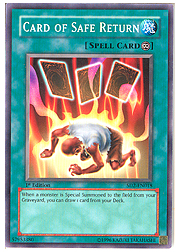 The problem came when the Zombie deck was in a position to over-extend and wreck some face, but didn’t have Card of Safe Return as a safety net. In that case it was often a coin toss whether or not an over-extension was ambitious and smart, or utterly ruinous. It really doesn’t matter how fast you drop three monsters if you run them all into Mirror Force, and Zombie decks were just as susceptible to strong defensive setups as any other battle-based strategy.
The problem came when the Zombie deck was in a position to over-extend and wreck some face, but didn’t have Card of Safe Return as a safety net. In that case it was often a coin toss whether or not an over-extension was ambitious and smart, or utterly ruinous. It really doesn’t matter how fast you drop three monsters if you run them all into Mirror Force, and Zombie decks were just as susceptible to strong defensive setups as any other battle-based strategy.
Goblin Zombie helps to free up options in that situation, since if you over-extend with one and wind up getting nailed by Torrential Tribute or Mirror Force, you’ll still get to replace the Goblin. Situations where you control a Pyramid Turtle and wish to press with another summon but fear losing cards become far easier to navigate when your second summon is a Goblin. Sure, your tempo still gets stolen away from you, but with that extra monster in your hand, you’ll be in a far better position to vie for control of the game next turn.
Think of it this way: all the gutsy plays that you used to pull with Card Trooper before it was Limited can be done with Goblin Zombie. Go ahead and swing into removal: as long as it’s not Dimensional Prison, you’re laughing. Heck, set a Goblin Zombie or two to goad more field development out of your opponent, then flip summon one and respond with your own Torrential Tribute. The search power of the Goblins will set you up with a Zombie Master (maybe more than one), and that means you’ll be swinging into a monster-free field with at least a Master and a Goblin.
Swarm decks always want to play aggressively, and any situation where they can’t puts them at a disadvantage. Card of Safe Return was the first card that let Zombies overcome this challenge, but Goblin Zombie is the second, and that makes it exceptionally useful.
Creature Swap Just Gets Better
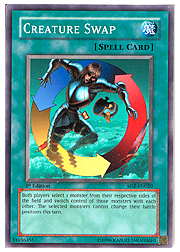 I’m actually in a bizarre minority of Zombie players who often loathe playing Creature Swap. It’s a conditional, low-utility card in a deck that already packs combo-dependent stuff in threes. Every time I open with something like Creature Swap, Card of Safe Return, and Book of Life with no Zombie, a little piece of me dies inside. That actually led me to eschew Creature Swap for most of the previous format.
I’m actually in a bizarre minority of Zombie players who often loathe playing Creature Swap. It’s a conditional, low-utility card in a deck that already packs combo-dependent stuff in threes. Every time I open with something like Creature Swap, Card of Safe Return, and Book of Life with no Zombie, a little piece of me dies inside. That actually led me to eschew Creature Swap for most of the previous format.
Whether or not that was a smart decision is debatable . . . and now, wholly irrelevant. Goblin Zombie provides you with three more hits for Creature Swap, which is a far more consistent component of the deck itself since you can now run it in threes. Sure, previous Zombie builds had two copies of Giant Rat to Swap over to the opponent (meaning that the count of Creature Swap-friendly monsters really only moves from five to six with the addition of Goblins over Rats), but the Goblins are just better for this purpose for a few reasons.
First, though the Rats had great synergy with Pyramid Turtle, that was the only reason they were in the deck. Fetching Card Trooper was nice, but both cards were off-theme and had no interaction with Il Blud or Book of Life, which is really pretty poor if you stop to think about it. Beyond that, if you sent over Giant Rat and your attacks didn’t make it through, that was a beating. It was an even bigger beating when the opponent then tributed the Rat to get it off his or her field. In that scenario you got absolutely nothing in return for your Creature Swap play.
But if Goblin Zombie is the monster tributed, you’ll still get to pull a Zombie from your deck. Your opponent will probably opt to play into that, so you won’t save yourself from his or her plans, but the play itself will be a bad one. Any time you can turn your opponent’s imperative moves into regrettable decisions is awesome, so I like to think of Goblin Zombie as serious insurance for the viability of my Creature Swap cards. I’ve been quite happy with the increase in utility that I’ve gained as a result.
A Brief Reflection On Deck Thinning
Going back to the speed issue, getting Zombie Master is just one way in which Goblin Zombie speeds things up. It also removes cards from your deck that would have kept you from drawing into Card of Safe Return, and you’ll often find yourself stalling out with one Goblin Zombie searching another just so you can thin your deck and go off earlier. Since Zombies have no way to search for their key spell card, this is a huge and highly underrated asset.
That Discard Effect Is Sweeter Than It Looks
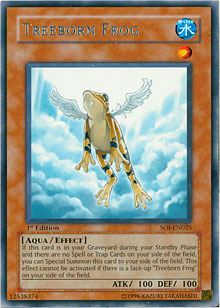 Back when Goblin Zombie was first announced in Shonen Jump Magazine, it was easy to discount the worth of its first effect. Everybody and their mother was playing Destiny Hero - Disk Commander, Destiny Hero - Malicious, and Treeborn Frog, meaning that a tenth of the average opponent’s deck was sheer poison if it was discarded by Goblin Zombie. I think a lot of players actually intended not to attack with Goblin whatsoever.
Back when Goblin Zombie was first announced in Shonen Jump Magazine, it was easy to discount the worth of its first effect. Everybody and their mother was playing Destiny Hero - Disk Commander, Destiny Hero - Malicious, and Treeborn Frog, meaning that a tenth of the average opponent’s deck was sheer poison if it was discarded by Goblin Zombie. I think a lot of players actually intended not to attack with Goblin whatsoever.
But that’s changed. Nowadays Goblin Zombie acts as an awesome pre-negator to cards that your swarm strategy has problems with (Marshmallon and Spirit Reaper in particular). It also messes with your opponent’s graveyard management, ditching things like Dark Magician of Chaos that you can then swipe with Monster Reborn, or sticking him or her with a fourth (or fifth, or sixth) Dark monster when the opponent would really like to summon Dark Armed Dragon.
Heck, even just eliminating random power cards that don’t have any special interactions in the Zombie matchup is excellent. Discarding Heavy Storm, Mirror Force, or Torrential Tribute is pretty formative and can decide the shape of the duel, giving you intelligence and tactical advantages. Theme-specific cards your opponent would like to actually use—such as D.D. Survivor, Dark Armed Dragon, or Bountiful Artemis—can all be taken out of the opposing deck on a lucky hit with Goblin Zombie.
I actually hadn’t really considered the impact of that fact until I saw it play out in a side game after the main event in Houston. I watched Eric Wu pilot a Zombie build against Hugo Adame, the latter playing Dark Armed Dragon. Early on in the duel, Wu summoned Goblin Zombie and attacked into Hugo’s face-down spell or trap. Hugo let the attack through, since wasting a defensive option to stop a paltry 1100 damage when he still had 8000 life points seemed unnecessary. So Hugo took the damage and proceeded to flip Crush Card Virus off the top of his deck into his graveyard. Neither duelist could believe what had just happened.
Beyond all the things you want to discard in today’s environment, the few cards that you didn’t want to discard are now seeing far less play. Malicious and Treeborn Frog are less common thanks to the fall of Monarchs. Even when you do discard something that could be useful to your opponent, you can frequently just move to main phase 2 and remove the problem card from play thanks to Book of Life. Activating Book after you attack instead of doing so before might be less than ideal, but as long as you bring back Pyramid Turtle or another Goblin, you’re not really losing anything by doing so.
Even More Trend Watching
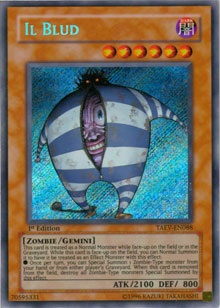 In fact, the trend of certain graveyard-live cards seeing less play is only one of many that have made Zombies a great pick for the average modern metagame. With Breaker the Magical Warrior now Forbidden, a Zombie duelist’s opponents will have one fewer piece of splashable spell and trap removal threatening Card of Safe Return. The choice to run Raigeki Break over Phoenix Wing Wind Blast also means you’ll see Zombies sent to the graveyard where they’re useful, as opposed to being returned to the top of your deck: an especially punishing play when it forced you to draw Il Blud or Ryu Kokki.
In fact, the trend of certain graveyard-live cards seeing less play is only one of many that have made Zombies a great pick for the average modern metagame. With Breaker the Magical Warrior now Forbidden, a Zombie duelist’s opponents will have one fewer piece of splashable spell and trap removal threatening Card of Safe Return. The choice to run Raigeki Break over Phoenix Wing Wind Blast also means you’ll see Zombies sent to the graveyard where they’re useful, as opposed to being returned to the top of your deck: an especially punishing play when it forced you to draw Il Blud or Ryu Kokki.
But above all the recent metagame trends contributing to the competitive viability of Zombies, I’d have to say the fall of Macro Cosmos is the best. I was shocked not to see new builds of the remove-from-play theme being played in Houston. I mean, hey, a winning deck with the addition of Van’Dalgyon the Dark Dragon Lord, Allure of Darkness, and Cyber Valley seemed good to me! But nobody really ran it, and if we see similar numbers from Macro Cosmos in the future, well, that takes the Zombie strategy’s toughest matchup right out of the picture.
The time is right, and since I’m writing this before Costa Mesa, it’s quite possible that Zombies may have already made their comeback. If that’s the case, then understand that Goblin Zombie is the primary reason for their return to Day 2. If they haven’t yet, consider the advantages this card offers to one of the most explosive, threatening strategies this game ever saw, and ask yourself if that’s the type of power you want to command at your next tournament.
—Jason Grabher-Meyer